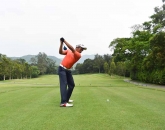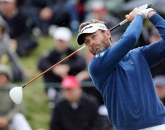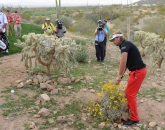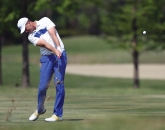‘Putting is more dependent on clarity of mechanics and movement than you ever believed. And it’s straightforward.’ So says Harold Swash, one of golf’s acknowledged putting gurus. In this special instructional article, Michael Monnard, a member of the Harold Swash Putting Schools of Excellence management team, takes you through the four fundamentals of a sound putting method.
It’s an often stated ‘fact’ that improving your putting is the quickest way to lowering your score and reducing your handicap. That may be so, but it doesn’t mean that a good and consistent putting stroke is easy to come by. Like all other aspects of your game, you need to work on it.
At the Harold Swash Putting Schools of Excellence we promote four fundamentals to Harold Swash’s sound putting method.
FUNDAMENTAL ONE
The blade of the putter needs to be square to the target at both the address and strike position.
This may not sound difficult, but most golfers don’t line up their putter in the best possible way in relation to the target. Most golfers simply don’t practice lining up properly. As such, the stroke is never going to be better than a compensation for poor alignment. This can lead to inconsistency under pressure.
To improve your ability to aim, use the Rail from Harold Swash method, which gives you immediate feedback of how you line up towards the target. It’s quite acceptable to use the logo of the golf ball to help line you up. Take advantage of it!
FUNDAMENTAL TWO
The blade of the putter needs to be square to the path through the hitting area.
In other words, we don’t want to put a slice or hook spin on the ball. If we are looking for the club to be square to the target line at impact, then we don’t want the path to cut across the ball inside-toout or outside-to-in. If we do this, the club face can be ‘closed’ or ‘open’ to the path at impact. This can cause the ball to move off its line due to side spin. Therefore, through the hitting area we are looking for the path to be along the ball to target line.
FUNDAMENTAL THREE
The putter blade needs to have a slight upstroke through the hitting area.
To have the best possible ball roll, it is crucial that you develop a slight ‘up-stroke’. Within this fundamental, the ball position and the hand start position are crucial.
The ball position is always in relation to the sternum – not in relation to the feet! Place the ball two inches ahead of the sternum to achieve the slight up-stroke through the ball in a natural manner.
To get the ball to roll as quickly as possible – which is the guiding principle of Harold Swash’s methodology – we also need our hands slightly forward at address and at point of strike. This will enable the correct amount of loft to be given to the putter at impact.
Most putters have four degrees of loft, which is too high. Yes! Golf C-Groove putters have 2.5 degrees of loft which – with the hands slightly ahead of the ball – is more likely to impart the correct degree of loft at impact to deliver the ideal ball roll.
If you have your hands behind the ball at impact, you will add loft to the putter. The ball will launch in the air upon impact.
FUNDAMENTAL FOUR
The club face should accelerate slightly through impact.
To be able to accelerate smoothly, use the shoulders instead of hands and/or wrists. Larger muscles are less prone to twitch and tic that can cause loss of control.
A very good exercise to check whether you use the shoulders or the wrists is the so-called ‘palm together’ drill. Make your strokes and practice swings this way and you will improve your wrist firmness.
Holding the club between the hands will strengthen your forearms to lock your wrists. Do this exercise every day.
Ideally, we are looking for a putting stroke where you can very easily control the acceleration. Too many people have a short or ‘too slow’ backswing. They then need to force the speed in the follow through. Consequently, they develop an ‘explosive’ follow through. This can cause distance control problems.
Or just the opposite can occur where a person has a long or ‘too quick’ backswing which makes it difficult to control velocity through impact.
The bigger muscles provide better timing and rhythm. If you just use your wrist, a small movement of your wrists is a big movement on the putter face. This will develop appropriate speed in the club face and your stroke will more likely become a hit.
Even after mastering these four fundamentals, there are still a lot of factors to consider on the road to becoming as good a putter as you can be. With each individual golfer, fine-tuning is required to perfect putting technique. However, one technical point that plays a large part in establishing a good set up to allow you to achieve many of the fundamentals we have talked about is the grip. Details in the next issue!











